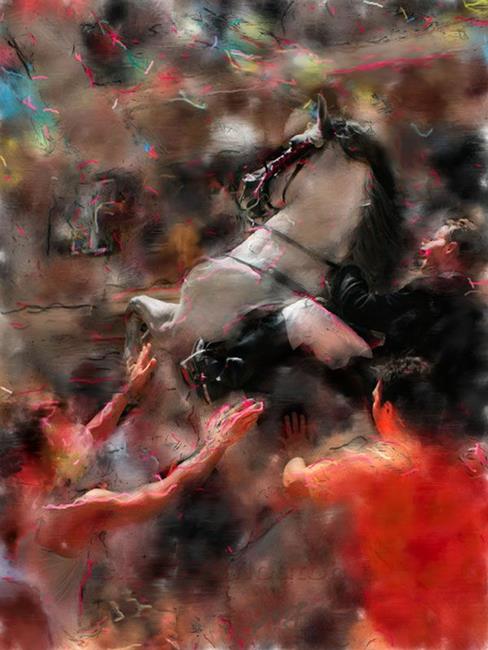SALE! Start your year with EBSQ for just $6.50/month! Click here for details.

The "Patron Saint" fiestas of the island of Menorca in the Mediterranean are a tradition which has its origin in the Fiestas of Saint John in Ciudadella (ancient capital of the island) which have been celebrated since the 14th century.
Sold-2007 The energetic but restrained horse, of noble blood lines is the principal protagonist of the fiesta. The riders, known as "caixers" dressed in traditional black and white costume resembling tuxedos which date from the 19th century with some detail from the 18th century, ride their charges through the streets of the village in a procession known as the "pasancalle", after which is celebrated the traditional "jaleo".
The jaleo is an emblematic act and key to the fiestas which are celebrated in the summer, beginning from the end of June through the beginning of September. The horses carrying their riders participate in a celebration in the main square, accompanied by music from the local band and a high spirited crowd.
The horses rear up or "jump" to the music of a well known jota (dance piece) which has been the signature piece of every fiesta since its beginnings. The excited and noisy crowd incites the horses to jump as a symbol of power and nobility. Each horse and rider takes its turn in the square. Three rounds are made, usually taking a few hours to accomplish, depending upon the number of riders.
The horses which rear and walk on their hind legs for the longest distance are cheered the most by the crowd. Some can easily cover 20-30 yards. and are also capable of intricate 'dance' steps which are part of their repertoire and training.
At the end of the celebration horse and ride approach the bandstand where the mayor and other officials award the rider with bull rushes/reeds which have a spoon tied to them in a cluster.
Although the riders are predominantly male, more women ride today, the first to have ridden over 30 years ago.
The fiesta has determined a particular style of riding and an equestrian spirit, which, along with the elegant dress and trappings, form an unmistakable menorquin equestrian identity hailed outside of the Balearic Islands as well.
I love these magnificent animals who are both spirited and gentle by nature. There is something about their style and beauty which has drawn me to photograph them year after year, searching for the definitive photograph. I have countless photographs of these animals and have chosen to depict one in a digital painting. They never cease to inspire me and hopefully one day I will achieve my quest.
Overall colors are intentionally saturated to intensify the spirit of the jaleo. Colored streaks of light also contribute to the spirit and highten the movement of the horse as the crowd energetically shouts ¡Olé, olé, olé!
Several videos showing horses performing dance steps, walking on their hind legs, and other moves can be found on YouTube.
Comments
By commenting, you agree to our Community Guidelines.















